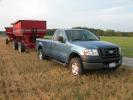|
The outflow of an I.C. engine is exactly the same as the inflow with one vital difference... gas temperature. It might go in at 100 degrees but it comes out at 6-1200 and greatly expanded. The problem is that the "ideal" exhaust size various almost infinitely according to engine speed, load and exhaust temp. All you can do is test, determine the size that's beneficial the majority of the time, and lose a little on either side of it. For economy, smaller is better but one factor to keep in mind in dealing with OE systems is that one of the major criteria/factors for the OE in designing a system is sound tuning. They will sacrifice some performance and economy to meet that goal by installing an overly restrictive muffler. There are better and worse exhaust system examples out there and the price of the car usually dictates how the OEM did the job and the compromises made.
Contrary to what was said above, backpressure is not necessary or desirable in and of itself but, especially with a carbureted engine, if it and engine was tuned/calibrated with a restrictive system, it must be retuned for the less restrictive system. EFI systems will adapt (most times) to a free flow exhaust but even they should undergo some measure of recalibration to optimize a free flow exhaust.
You can calculate exhaust flow if you have the intake flow in CFM, and the exhaust temp using the formulae below.
First, you need to know how much air is going in. You can calculate a maximum, which is done for performance systems, or you can calculate at a specific rpm at which you want to tune. We'll use 3000.
Naturally Aspirated Intake Airflow in CFM
cubic inches x rpm
________________ x volumetric efficiency* = airflow in cfm
3456
* Most engine are 80-85 percent efficient on average. At lower rpms, they are generally at the higher end, the good one getting to 90 percent and sometimes more, at peak torque.
Example using a 2.3L (140ci) eng-
140 x 3000
_________ x .90 = 109.37 cfm
3456
To get exhaust flow, you need to know the exhaust temp at the speed and engine load you want to tune for, which is highly variable. I have a lot of data on diesels (max economy in a deisel usually occurs at 550 F EGT, for example) and could make an average "guesstimate" but not much on gassers. The only way to know is to install a pyrometer on your engine and find out. I'll use 600 degrees as an average for a gasser at a moderate load. The "460" and "540" are constants and I don't have time to go into what they are.
exhaust temp in Fahrenheit + 460
___________________________ x intake airflow cfm = exhaust flow
540
Example for our 2.3L at 600 degree EGT (at the previously determined 3000 rpm)
600 + 460
________ x 109.37 = 214.69 cfm exhaust flow
540
You can find the exhaust flow of many performance mufflers at various manufacturers sites and sometimes in performance magazines. OEM parts... you'll have to test yourself. I have done a bit of that and some OEM systems are surprisingly good... some abysmal. Most are OK for low rpm use. As to pipe size, the flow will vary according to the number of bends but see below for some average number for straight pipe. At a given diameter, number of bends and airflow, a mandrel bent system will have 27 percent less backpressure than a typical crimped system. This I have seen personally on a flow bench.
Straight Pipe Flow By Diameter
5-inch: 2200 cfm +
4-inch: 1800 cfm
3.5-inch: 1400 cfm
3-inch: 1200 cfm
2.5-inch: 900 cfm
2.25-inch: 600 cfm
I do not have data below 2.25 inch pipe.
As someone said above, scavenging is the ideal but that effect is elusive and dependent on gas velocity. With small pipes, relative to displacement/gasflow, the effect comes on at a lower rpm and the larger the pipe the later it comes. The trick is finding a balance between scavenging at a workable, efficient rpm and restriction when you have to rev higher. The OE strives for a balance, but we are free to focus as narrowly as we want and lie with whatever compromise you decide to make.
__________________
Jim Allen
The Frugal Four Wheeler and Farmer
My ultimate goal is not necessarily the highest mpg but to make my trucks more efficient configured as I need them.
Old Reliable '86 Ford F-250HD 4x4, 6.9L diesel
Red '00 Honda Accord Coupe, 3.0L V6, automatic
The Plugger '05 Ford F-150HD 4x4, Regular Cab, 8-ft bed, 8,200# GVW, 5.4L V8, automatic, 4.10:1 ratios, 285/70R-17D tires

|